December 6 2012. Burlington ON. A small group of regular walkers convinced me to join them for a quick lunchtime march through woodland trails and along a small river valley. It was quite cold but with the sun shining it was not unpleasant. We were quite surprised by the bird activity including several White-breasted Nuthatches, Northern Cardinals, Downy Woodpeckers and even a boldly marked White–throated Sparrow that was hopefully examining the top branches of a bare Manitoba Maple. Two Red–tailed Hawks flew heavily through the trees to emerge into the open over the river flats provoking discussion among us as to their respective ages; I figured they were both immature birds. The hawks’ presence offended some of the smaller birds but none quite as much as a Belted Kingfisher that darted up river in the bouncing flight and rattling call that makes the kingfisher unmistakable. Its presence made it Bird of the Day, it seems late for kingfishers to still be around. I’m sure most have long gone farther south, but I guess as long as there’s open water and fish to be caught, there’s a living to be had.
Author: Peter T
Gadwall
December 5 2012. Valley Inn Hamilton ON. A serious winter wind was blowing out of the north-west today. It looked decent enough early on, the sky was mostly open and the sun shining. But a far-off bank of piled cumulus clouds was getting its ice-smooth tops torn away in streamers. At ground level the wind was buffeting me and made my eyes water.
I visited one of our most productive waterfowl inlets hoping for some interesting ducks. Two bird photographers dressed in heavy winter parkas with hoods up, were standing on the shore cradling long-lens equipment and hoping for something to show up; they looked cold to the bone. But Lake Ontario is at a 35-year low and these watery inlets that are usually shallow and a happy place for ducks are now dry; just mudflats.
In a remnant puddle, far from the shore, was a group of Mallards and a solitary male Hooded Merganser floating disconsolately, his head tucked under his wing and hoping the wind would soon drop. The only other sign of life was a small group of Gadwall, they were in a sheltered spot with a modicum of water and seemed quite active and even satisfied with their lot in life.
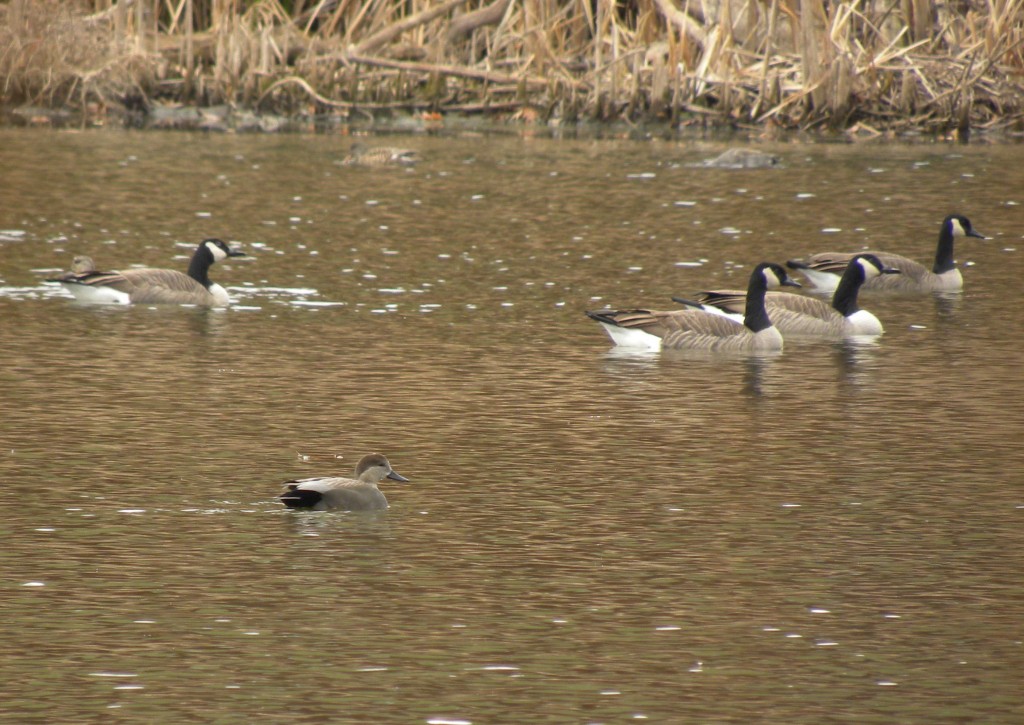
Looking at them, handsome in a grey and brown manner, I was reminded how Pete Dunne describes them in his Essential Field Guide Companion book: “Fairly common and conservative, in both attire and social commitments. Males make a fashion statement with tasteful gray…..” It’s true, there’s something rather Bank of England about them; well dressed, confident and yet subdued. Bird of the Day because they’re reassuring; cold wind or not, all is well with the world.
[slickr-flickr tag=”gadwall”]
Scoters – White-winged and Black
December 1 2012. Burlington ON. Heading home after a morning spent watching over crowds of children of all ages enjoying a spectacular model train show put on especially for the Christmas season, I needed a dose of bird-time. So I made a detour to a popular boaters’ and birders’ hangout, a marina for six months of the year, on the shore of the bay.
Our winters are usually deeply cold, cold enough that the pressure of ice around moored boats could crush the hulls. Every October the boats are lifted out of the lake and stored high and dry in fenced compounds, a process and expense that must surely sort out the sailors who are either really serious or have ample financial resources; probably both, from the mere dreamers. So at this time of year, marinas around the Great Lakes are largely empty except for fisherman, dog-walkers and birds and their admirers.
Winter usually brings in a varied collection of waterfowl to the bay, sometimes a rarity shows up, as did a young Common Eider last winter and a Barrows Goldeneye a decade or so ago; it’s usually an interesting stop, sometimes only for a quick leg-stretch.
Today I enjoyed several Trumpeter Swans mixing in with American Coots and Red–breasted Mergansers. A bit farther offshore a raft of Rudy Ducks bobbed like a line of linked marker buoys together with Lesser Scaups and a few Common Goldeneyes. Then my attention was grabbed by a Black Scoter, its flattened shovel-like bill a striking pale orange like an egg yolk in vivid contrast to its coal black body and head.
Much farther out were a few more Black Scoters and also many White–winged Scoters. At the distance involved the White-winged were distinguishable only by the flash of white at their wingtips. Between them they made the stop worthwhile, scoters were my instant Bird of the Day.
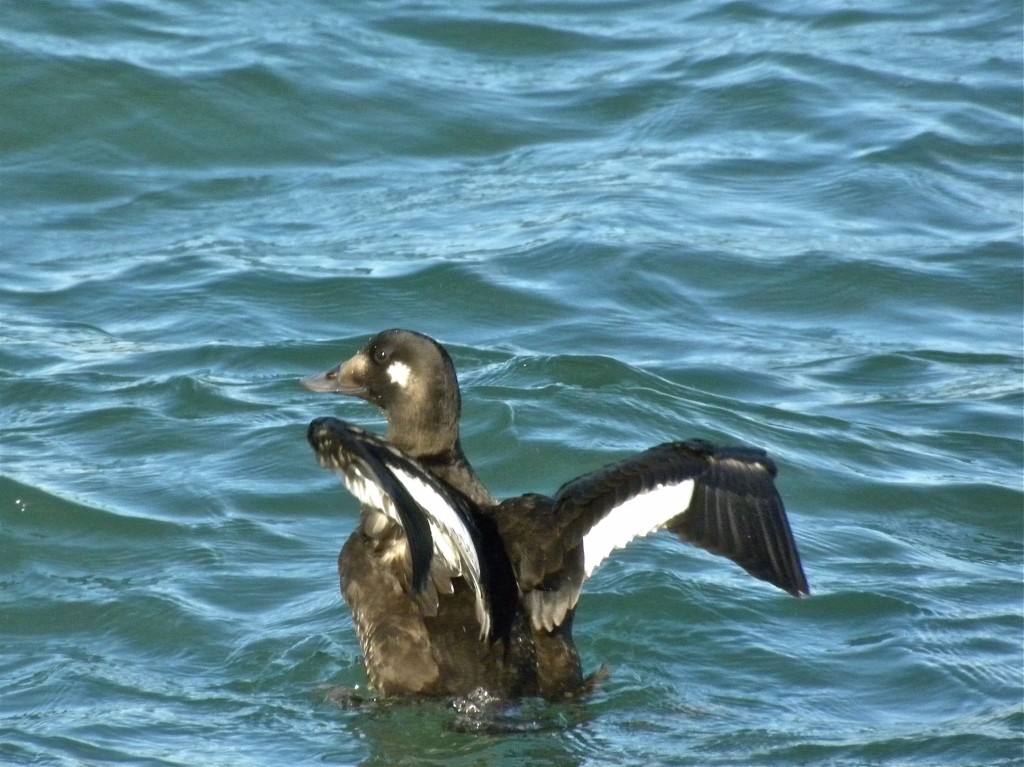
[slickr-flickr tag=”lakescoter”]
The word ‘scoter’ according to my bird names reference, is probably a variant of the word coot; to which they have a superficial similarity. There are three scoter species, only the Surf Scoter was not seen today, but all of them are rather large, very dark brown to jet black, somewhat lumpy looking ducks. The distinguishing field marks are fairly easily grasped, but in a pinch can be distilled to: the Black Scoter is black, the White-winged Scoter has white in its wings and the Surf Scoter isn’t quite the same as either of the others. Females are different again, lots of brown tones; difficult birds! All breed in Arctic waters but arrive to winter on Lake Ontario, mostly White-winged Scoters, in their hundreds of thousands in November and December. It wasn’t always that way, their fairly recent arrival here is linked to the abundance of Zebra Mussels that have invaded the Great Lakes in the last couple of decades. The mussels are a seemingly inexhaustible supply of high protein food easily plucked off the bottom by diving ducks like scoters, goldeneyes, Long-tailed Ducks, scaup and Buffleheads. They have transformed winter birding on this lake.
Peregrine Falcon
November 27 2012. Burlington ON. Not very long ago, certainly within my easy-recall memory, Peregrine Falcons were very rare and seeing one was a gold medal sightings. But with the resurgence of their population aided by conservationists’ encouragement, there are now many places in the urbanized world where peregrines are well established, even routine; my home city is one of them.
About a mile from home are three side by side large bridges that vault road traffic over a busy shipping canal, two have long yawning spans while the third is a lift bridge of more modest reach but vastly more complex structure. The lift bridge has two tall blocky towers housing the enormous lifting gear which serves to haul up the canal-width road deck, the weight of which is counterbalanced by massive weights. Peregrine Falcons first appeared and set up home on one of the bridge towers five or six years ago, and other than a disaster that first year the nest site has been successful. From the peregrine’s point of view the location has a lot going for it: a high commanding site inaccessible to most predators, and an inexhaustible supply of Rock Pigeons, Long-tailed Ducks and Ring-billed Gulls.
Anytime from March through June you can almost count on seeing at least one of ‘our’ Peregrine Falcon on or near the bridge. As for the rest of the year, well they’re around, but seeing one is a hit and miss affair. In this spring photo of the female she was perched on a cable strung above the bridge deck, while her mate careened around screaming and proclaiming his fealty.
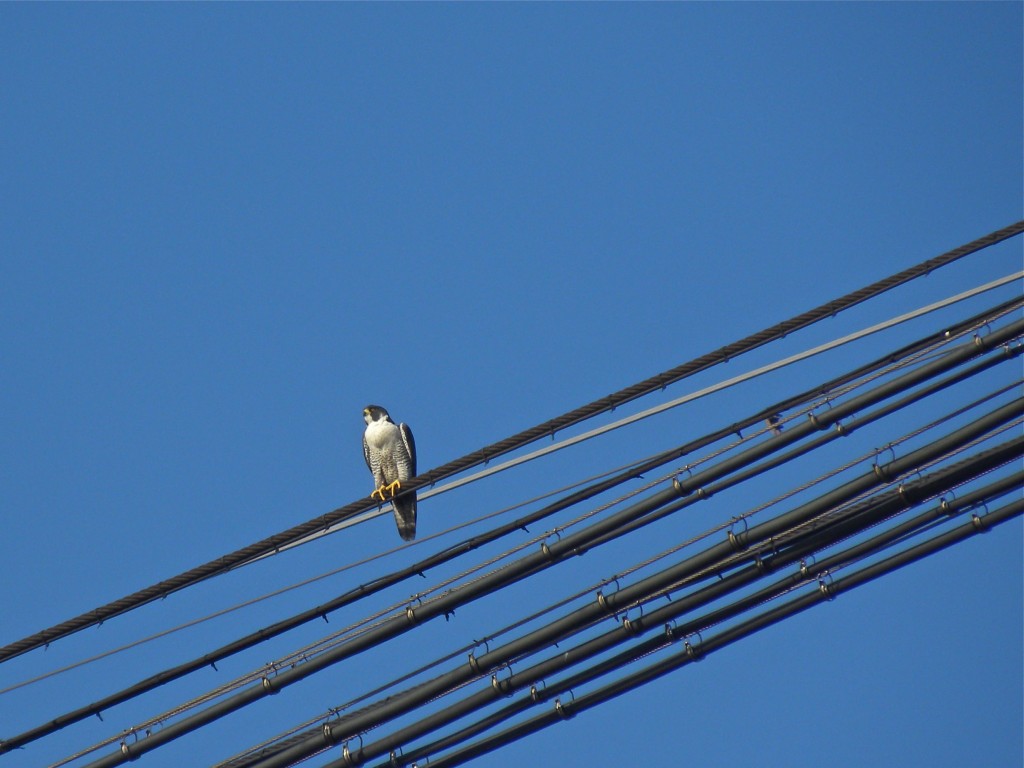
Today we set out in quest of flooring and plumbing parts to complete some bathroom improvements. In the midst of one of life’s most mundane activities, driving up an on-ramp to join a highway, a Peregrine Falcon swept low over us heading in the opposite direction. I knew it immediately, Peregrines are a hefty, purposeful and strong winged falcon, graceful and almost gull-like in outline but in no way ballerina-esque. I enjoyed the moment and knew it would be hard to beat as Bird of the Day. But then heading home and this time closer to the lift bridge we had the same encounter, a Peregrine Falcon passing low overhead its wing beats strong yet somehow seeming to be little more than casual wrist-flicks. Twice in a one day affirms the Peregrine Falcon as Bird of the Day.
Trumpeter Swans
November 25 2012. Today was a get-out-of-the-wind day; probably the first of this season and certainly not the last. I had to inspect some properties for a volunteer position I hold and my tour took me to a number of lakeside properties. There were snowflakes swirling in the air, and the sky was dark and troubled, the sort of weather a radio announcer called Beethoven Weather.
The birding was rather thin, especially among passerines, although I managed to catch a glimpse of a couple of Carolina Wrens working low in the fallen leaves under some overgrown Forsythia shrubs.
Funny thing about approaching the lake in colder months is that there always seems to be an on-shore wind, so it can be an eye-watering challenge. Collar turned up, head down and hand on hat to keep it (the hat) from blowing away, I explored a couple of stretches of rocky shorelines and found that many birds shared my dim view of current conditions. I was quite struck by this group of hunkered-down Mallards, how they seem to blend in with the surrounding rocks both in shape and size as well as overall colour tone.
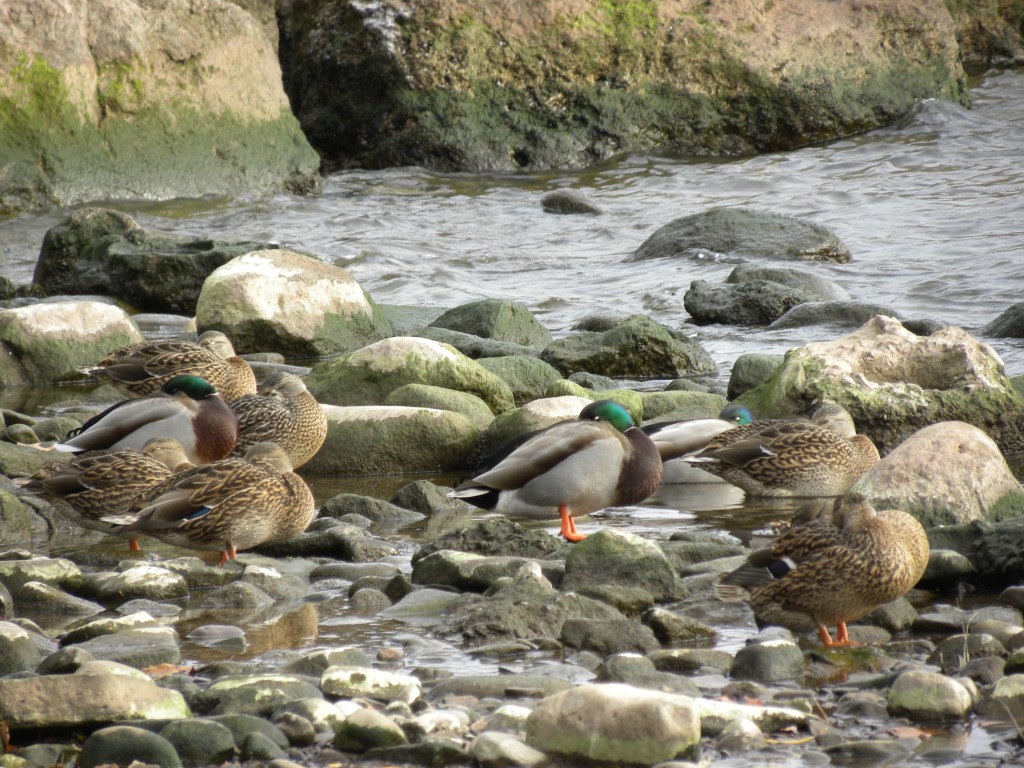
We have a flock of Trumpeter Swans that stays in our bay all winter. Their presence here has quite a story; Trumpeter Swans were extirpated from Ontario by over-hunting sometime well before early ornithologists started keeping records. About 30 years ago efforts were made to re-introduce them. The results were promising right from the get-go and to cut a long story short it has been successful to the extent that a stable and sustainable population now winters along the shoreline of Lake Ontario and breeds within two or three hundred kilometers north of it.
The group I watched this morning was feeding, muttering among themselves with their unique trumpet-blast call note and staying out of the wind.
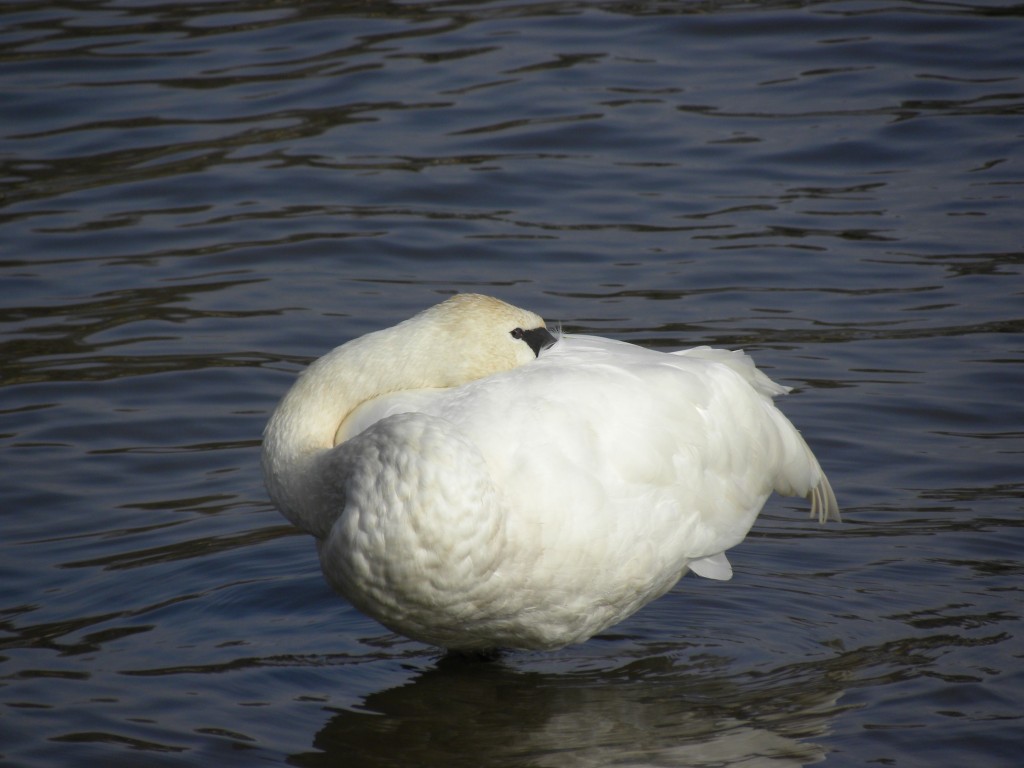
Trumpeter Swans were my Birds of the Day because they were easy to see and enjoy, but offshore I saw many Redheads, Canvasbacks, Lesser Scaup, Common Goldeneyes, Buffleheads and Ruddy Ducks; all nice birds in their own way, and their turn as bird of the day will surely come. [slickr-flickr tag=”trumpeter”]